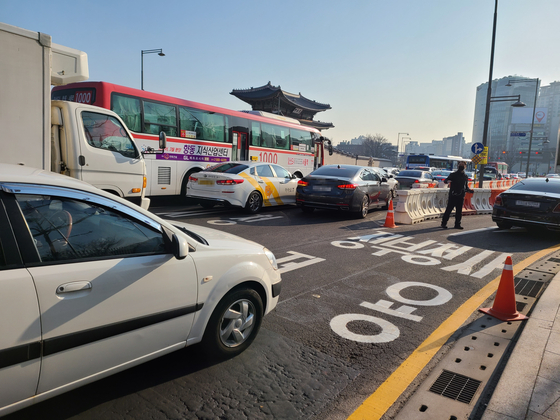“Even if it was blocked from Hyoja-dong to Gyeongbokgung Station, it was 10 minutes, but today it took more than 20 minutes.”
On the 8th, when the west road (in front of Sejong Center) was closed due to the restructuring of Gwanghwamun Square, traffic jams and confusion occurred in various places near Gwanghwamun. Taxi driver Yumo said, “A customer just got on from Hyoja-dong to go to Yeouido and asked to get off at Gwanghwamun Station because it was blocked. However, the road to Gwanghwamun was blocked and eventually got off at Gyeongbokgung Station.”
The road on the west side of Gwanghwamun Square was banned from the 6th. Only vehicles entering the Seoul Government Complex can enter the west road, while other vehicles must go straight further and use the east road. As the road on the east side was changed to a two-way traffic due to the closure of the west road, the entire driving lane was reduced from 10 lanes to 7 lanes.

On the 8th, the first weekday after the road on the west side of Gwanghwamun Plaza was closed, traffic congestion and congestion occurred in various places in Gwanghwamun. Reporter Kwon Hye-rim
Vehicles turning right toward the square as resignation’confusion’
On the way to work this morning, there was a smooth flow on the east road, but traffic jams continued in the right-turn lane entering the square from the Gwanghwamun intersection.
Kim Mo (57), a taxi driver, said, “Originally, when turning right towards Gwanghwamun Square, most of them passed without a stop, but now there are two signals, so traffic congestion is inevitable.” It seems that there is more confusion because it is in a state.” Kim Mo (70), an exemplary driver in charge of traffic control, said, “I am in a hurry because of the crowds of vehicles trying to turn right.”
An official at the Jongno Police Station said, “In the original, right-turning vehicles were driven out by two lanes in front of the Seoul Government Complex, but in the current situation, there is a congestion because it is receiving two signals when turning right.” It’s the same,” he said. He added, “I expect the traffic conditions will also stabilize in a week or two.”

Changes to the traffic system around Gwanghwamun Square. Graphic = Reporter Jaemin Shin [email protected]
The city officials and the exemplary driver belonging to the Jongno Police Station worked hard to block a right-turning vehicle attempting to enter the road in front of the Seoul Government Complex as before. Officials in Seoul continued to guide each vehicle, saying, “Are you going to the government building? Or you have to use the lane next to it.” It was often seen that the vehicle that had entered the vehicle recklessly without hearing the guidance often returned to the reverse direction.
Drivers who were trying to make a right turn to Gwanghwamun West Road after passing Sajik-ro 8-gil between the Seoul Government Complex and the Ministry of Foreign Affairs were forced to make a U-turn and return. One driver said, “I had no idea it was blocking the road.”
“I’ll be out of the house early for the time being”

Due to the restructuring of Gwanghwamun Square, vehicles are passing in both directions on the east side of the plaza instead of on the west side on Sejong-daero in Seoul on the morning of the 8th. yunhap news
Some citizens also suffered inconvenience as the stop in front of the Sejong Center for the Performing Arts moved across from the US Embassy in Korea. Shinmo (60), a walking assistant who was assigned to guide the detour road from 8 am, said, “A few people asked where to go, saying that the bus stop in front of the Sejong Center for the Performing Arts has disappeared. People who have not yet known even though they have been notified from the past There are a lot of guides,” he said.
Park Mo (38), an office worker who took a bus from Eunpyeong-gu, said, “It was the first time I knew I had just got off the stop.” “It took 10 minutes to get from the Gyeongbokgung Station intersection to the Gwanghwamun Intersection, so I wondered why. I plan to leave a little earlier from my house for the time being. “I said.
Bus stops are more concerned about congestion during work hours than during work hours. “It’s okay for citizens to scatter as soon as they get off during the rush hour, but it’s okay to get off the bus as soon as they get off at work,” said No Byeong-chun, head of the bus policy section of the Seoul Metropolitan Government. Said.
According to the Seoul Metropolitan Government, the average speed of the entire section of Sejong-daero from 7 am to 9 am on this day was 25.2 km. Compared to the same time zone last week, it is about 2.5 km/h. Seoul Mayor Seo Jeong-hyup visited the site to check the traffic situation and the reorganized transportation system, and said, “As the transportation system changes, confusion and congestion may occur in the beginning, so that the inconvenience of citizens is minimized and the transportation system is stabilized as soon as possible. Please, “he asked.
Reporter Kwon Hye-rim [email protected]
![]()
